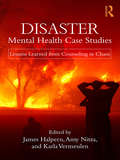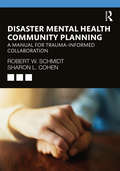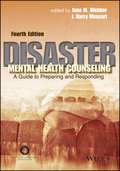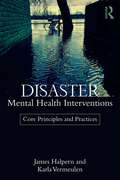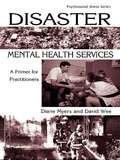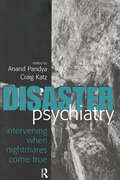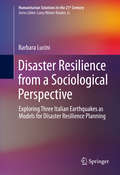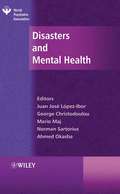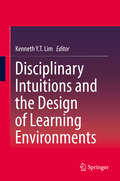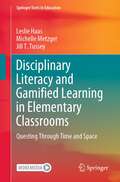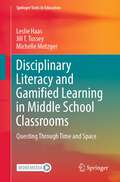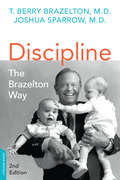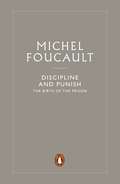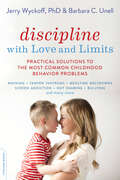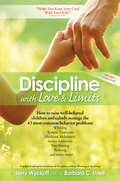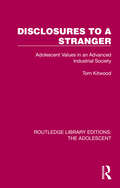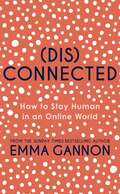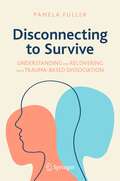- Table View
- List View
Disaster Mental Health Case Studies: Lessons Learned from Counseling in Chaos
by James Halpern Amy Nitza Karla VermeulenDisaster Mental Health Case Studies is a riveting collection of case studies by master clinicians that reveal how disaster mental health interventions must be tailored to meet the needs of survivors. Each unique case study is structured to give the reader an introduction to the community affected pre-disaster; a glimpse into the thought processes of the disaster mental health responders pre- and post-disaster; and a reflective selection of lessons learned as a result of the experiences. The 17 case studies offer the reader: Guidance on how to develop an empathic approach to disaster mental health response; Exposure to a diverse sample of disaster contexts, including naturally-occurring disasters, human-caused disasters, and disasters which occurred in an international setting; An understanding of the strategic approaches needed for disaster mental health service response, as well as an appreciation of the need for self-care when responding; A grounded and accessible writing style, bookended by chapters from the editors which thematically link and analyze the case studies. Offering a rare and compelling view into the challenges, tragedies, pain, frustrations, and grief at the heart of disaster mental health work, this must-have collection is tailored to appeal to students of mental health and counseling, psychology, and social work; and working mental health professionals who would like to learn directly from experienced responders.
Disaster Mental Health Case Studies: Lessons Learned from Counseling in Chaos
by James Halpern Amy Nitza Karla VermeulenDisaster Mental Health Case Studies is a riveting collection of case studies by master clinicians that reveal how disaster mental health interventions must be tailored to meet the needs of survivors. Each unique case study is structured to give the reader an introduction to the community affected pre-disaster; a glimpse into the thought processes of the disaster mental health responders pre- and post-disaster; and a reflective selection of lessons learned as a result of the experiences. The 17 case studies offer the reader: Guidance on how to develop an empathic approach to disaster mental health response; Exposure to a diverse sample of disaster contexts, including naturally-occurring disasters, human-caused disasters, and disasters which occurred in an international setting; An understanding of the strategic approaches needed for disaster mental health service response, as well as an appreciation of the need for self-care when responding; A grounded and accessible writing style, bookended by chapters from the editors which thematically link and analyze the case studies. Offering a rare and compelling view into the challenges, tragedies, pain, frustrations, and grief at the heart of disaster mental health work, this must-have collection is tailored to appeal to students of mental health and counseling, psychology, and social work; and working mental health professionals who would like to learn directly from experienced responders.
Disaster Mental Health Community Planning: A Manual for Trauma-Informed Collaboration
by Robert W. Schmidt Sharon L. CohenDisaster Mental Health Community Planning is a step-by-step guide to developing mental health disaster plans, assisting communities to act on long-term resilience and recovery. As disasters continue to increase in severity and number, with 16% of survivors identified as potential PTSD victims if they don't promptly receive care, this book is a critical read. Chapters outline how to prepare, develop, and implement a trauma-informed collaborative process that prioritizes lasting emotional wellbeing along with survivors’ short-term needs. The manual demonstrates how to form this partnership through effective communication, assess those individuals at greatest risk of distress, and deliver trauma-specific treatment. Readers will appreciate the book’s practical, user-friendly approach, including case studies, checklists, and follow-up questions to better define goals. Cutting-edge treatment interventions are included along with basic information on trauma's impact on the brain and the types and effects of human-caused and natural disasters to help readers make sound planning decisions. Accessible to mental-health providers, community leaders, organizations, and individuals alike, Disaster Mental Health Community Planning is a Road Map for anyone interested in delivering a trauma-informed mental health supplement to their community's medical disaster preparedness and response plan.
Disaster Mental Health Community Planning: A Manual for Trauma-Informed Collaboration
by Robert W. Schmidt Sharon L. CohenDisaster Mental Health Community Planning is a step-by-step guide to developing mental health disaster plans, assisting communities to act on long-term resilience and recovery. As disasters continue to increase in severity and number, with 16% of survivors identified as potential PTSD victims if they don't promptly receive care, this book is a critical read. Chapters outline how to prepare, develop, and implement a trauma-informed collaborative process that prioritizes lasting emotional wellbeing along with survivors’ short-term needs. The manual demonstrates how to form this partnership through effective communication, assess those individuals at greatest risk of distress, and deliver trauma-specific treatment. Readers will appreciate the book’s practical, user-friendly approach, including case studies, checklists, and follow-up questions to better define goals. Cutting-edge treatment interventions are included along with basic information on trauma's impact on the brain and the types and effects of human-caused and natural disasters to help readers make sound planning decisions. Accessible to mental-health providers, community leaders, organizations, and individuals alike, Disaster Mental Health Community Planning is a Road Map for anyone interested in delivering a trauma-informed mental health supplement to their community's medical disaster preparedness and response plan.
Disaster Mental Health Counseling: A Guide to Preparing and Responding
by Jane M. Webber J. Barry MascariThis timely book provides current research and skill-building information on Disaster Mental Health Counseling for counselors, educators, students, and mental health responders in agencies, schools, universities, and private practice. Recognized experts in the field detail effective clinical interventions with survivors in the immediate, intermediate, and long-term aftermath of traumatic events. This extensively revised edition, which meets 2016 CACREP Standards for disaster and trauma competencies, is divided into three sections: Disaster Mental Health Counseling Foundations, Disaster and Trauma Response in the Community, and Disasters and Mass Violence at Schools and Universities. Real-world responses to violence and tragedies among diverse populations in a variety of settings are presented, and responders share their personal stories and vital lessons learned through an "In Our Own Words" feature. Each chapter contains discussion questions and case studies are interwoven throughout the text. Requests for digital versions from the ACA can be found on wiley.com. To request print copies, please visit the ACA website here. Reproduction requests for material from books published by ACA should be directed to permissions@counseling.org
Disaster Mental Health Counseling: A Guide to Preparing and Responding
by Jane M. Webber J. Barry MascariThis timely book provides current research and skill-building information on Disaster Mental Health Counseling for counselors, educators, students, and mental health responders in agencies, schools, universities, and private practice. Recognized experts in the field detail effective clinical interventions with survivors in the immediate, intermediate, and long-term aftermath of traumatic events. This extensively revised edition, which meets 2016 CACREP Standards for disaster and trauma competencies, is divided into three sections: Disaster Mental Health Counseling Foundations, Disaster and Trauma Response in the Community, and Disasters and Mass Violence at Schools and Universities. Real-world responses to violence and tragedies among diverse populations in a variety of settings are presented, and responders share their personal stories and vital lessons learned through an "In Our Own Words" feature. Each chapter contains discussion questions and case studies are interwoven throughout the text. Requests for digital versions from the ACA can be found on wiley.com. To request print copies, please visit the ACA website here. Reproduction requests for material from books published by ACA should be directed to permissions@counseling.org
Disaster Mental Health Interventions: Core Principles and Practices
by James Halpern Karla VermeulenDisaster Mental Health Interventions uses DSM-5 diagnostic criteria and the latest research to help build disaster mental health intervention skills that will last a lifetime. Students and emerging professionals across the fields of mental health counseling, social work, school counseling, spiritual care, and emergency management will appreciate the accessible tone, level of detail, and emphasis on practice. Case studies and anecdotes from experienced professionals add an additional level of depth and interest for readers.
Disaster Mental Health Interventions: Core Principles and Practices
by James Halpern Karla VermeulenDisaster Mental Health Interventions uses DSM-5 diagnostic criteria and the latest research to help build disaster mental health intervention skills that will last a lifetime. Students and emerging professionals across the fields of mental health counseling, social work, school counseling, spiritual care, and emergency management will appreciate the accessible tone, level of detail, and emphasis on practice. Case studies and anecdotes from experienced professionals add an additional level of depth and interest for readers.
Disaster Mental Health Services: A Primer for Practitioners (Psychosocial Stress Series)
by Diane Myers David WeeDisaster mental health is a growing field of practice designed to help victims and relief workers learn to effectively cope with the extreme stresses they will face in the aftermath of a disaster. The goal of disaster mental health is to prevent the development of long-term, negative psychological consequences, such as PTSD. This book assists clinicians and traumatologists in "making the bridge" between their clinical knowledge and skills and the unique, complex, chaotic, and highly political field of disaster. It combines information from a vast reservoir of prior research and literature with the authors' practical and pragmatic experience in providing disaster mental health services in a wide variety of disasters.
Disaster Mental Health Services: A Primer for Practitioners (Psychosocial Stress Series)
by Diane Myers David WeeDisaster mental health is a growing field of practice designed to help victims and relief workers learn to effectively cope with the extreme stresses they will face in the aftermath of a disaster. The goal of disaster mental health is to prevent the development of long-term, negative psychological consequences, such as PTSD. This book assists clinicians and traumatologists in "making the bridge" between their clinical knowledge and skills and the unique, complex, chaotic, and highly political field of disaster. It combines information from a vast reservoir of prior research and literature with the authors' practical and pragmatic experience in providing disaster mental health services in a wide variety of disasters.
Disaster Psychiatry: Intervening When Nightmares Come True
by Craig L. Katz Anand A PandyaDisaster Psychiatry: Intervening When Nightmares Come True captures the state of disaster psychiatry in the aftermath of the terrorist attacks of September 11, 2001. This emergent psychiatric specialty, which is increasingly separated from trauma and grief psychiatry on one hand and military psychiatry on the other, provides psychotherapeutic assistance to victims during, and in the weeks and months following, major disasters. As such, disaster psychiatrists must operate in the widely varying locales in which natural and man-made disasters occur, and they must establish their role among the chaotic array of organizations involved in direct disaster response. Editors Anand Pandya and Craig Katz have captured the challenge and promise of disaster psychiatry through first-person narratives. We hear from psychiatrists who have encountered disasters at various stages of their career and in widely varying social, political, and personal contexts. Accounts of psychiatric involvement with adults and children during and after 9/11 have understandable pride of place in this collection. But they are balanced by richly informative narratives about other domestic and international disasters. Fraught with the drama attendant to the events they describe, these essays delineate the dizzying array of challenges that confront the disaster psychiatrist. They range from the intense emotional responses that are part of the aftermath of any disaster, to the need to legitimize a psychiatric presence within diverse cultural and medical contexts, to the subtle task of providing therapeutic boundaries at a time when all rules seem to be suspended. Special attention is given to the daunting task of working with children whose parents' are disaster victims. What emerges from these testimonies is compelling documentation of skilled and compassionate psychiatrists at the outer limits of their specialty, pursuing their calling into uncharted realms of therapeutic engagement.
Disaster Psychiatry: Intervening When Nightmares Come True
by Anand A. Pandya Craig L. KatzDisaster Psychiatry: Intervening When Nightmares Come True captures the state of disaster psychiatry in the aftermath of the terrorist attacks of September 11, 2001. This emergent psychiatric specialty, which is increasingly separated from trauma and grief psychiatry on one hand and military psychiatry on the other, provides psychotherapeutic assistance to victims during, and in the weeks and months following, major disasters. As such, disaster psychiatrists must operate in the widely varying locales in which natural and man-made disasters occur, and they must establish their role among the chaotic array of organizations involved in direct disaster response. Editors Anand Pandya and Craig Katz have captured the challenge and promise of disaster psychiatry through first-person narratives. We hear from psychiatrists who have encountered disasters at various stages of their career and in widely varying social, political, and personal contexts. Accounts of psychiatric involvement with adults and children during and after 9/11 have understandable pride of place in this collection. But they are balanced by richly informative narratives about other domestic and international disasters. Fraught with the drama attendant to the events they describe, these essays delineate the dizzying array of challenges that confront the disaster psychiatrist. They range from the intense emotional responses that are part of the aftermath of any disaster, to the need to legitimize a psychiatric presence within diverse cultural and medical contexts, to the subtle task of providing therapeutic boundaries at a time when all rules seem to be suspended. Special attention is given to the daunting task of working with children whose parents' are disaster victims. What emerges from these testimonies is compelling documentation of skilled and compassionate psychiatrists at the outer limits of their specialty, pursuing their calling into uncharted realms of therapeutic engagement.
Disaster Resilience from a Sociological Perspective: Exploring Three Italian Earthquakes as Models for Disaster Resilience Planning (Humanitarian Solutions in the 21st Century)
by Barbara LuciniNatural disasters traumatize individuals, disrupt families, and destabilize communities.Surviving these harrowing events calls for courage, tenacity, and resilience. Professional planning requires specific types of knowledge of how people meet and cope with extreme challenges.Disaster Resilience from a Sociological Perspective examines three major earthquakes occurring in Italy over a fourteen - year period for a well-documented analysis of populations' responses to and recovery from disaster, the social variables involved, and the participation of public agencies. This timely volume reviews sociological definitions and models of disaster, identifying core features of vulnerability and multiple levels of individual and social resilience. The analysis contrasts the structural and supportive roles of Italy's civil protection and civil defense services in emergency planning and management as examples of what the author terms professional resilience. And testimony from earthquake survivors and volunteers gives voice to the social processes characteristic of disaster. Among the areas covered:Social context for concepts of disaster, vulnerability, risk, and resilienceTypes of resilience: a multidimensional analysis, focused on a physical, ecological, and ecosystem perspectiveFindings from three earthquakes: loss, hope, and community.Two systems of organizational response to emergenciesToward a relational approach to disaster resilience planning Plus helpful tables, methodological notes, and appendicesFor researchers in disaster preparedness, psychology, and sociology, Disaster Resilience from a Sociological Perspective raises--and addresses--salient questions about people and communities in crisis, and how studying them can improve preparedness in an uncertain future.
Disasters and Mental Health (World Psychiatric Association #4)
by Juan José López-Ibor George Christodoulou Norman Sartorius Ahmed OkashaThis title provides a comprehensive overview of clinical, epidemiological, psychobiological, psychosocial and service organization aspects of disaster psychiatry. It takes a practical approach and includes a series of reports on significant experiences made in this field in various regions of the world. An Unbiased and reliable reference point, endorsed by the WPA Includes contributions from internationally acclaimed experts
Disciplinary Intuitions and the Design of Learning Environments
by Kenneth Y. T. LimAs children, we would have spilt glasses of milk, dropped things, and broken things. As children, therefore, we would have developed intuitions about how the world ‘works’, but we would not necessarily have been able to explain these ‘workings’. It would only have been till we entered formal schooling that we would have learned codifications of canon within each respective discipline, and consequently how to articulate the canon to explain the intuition.The preceding example was from the natural sciences, but one could just have easily taken an example from, say, the environmental sciences or from the social sciences. Indeed, much of this book does just that, as it seeks to chart the territory of a new theory of learning around Disciplinary Intuitions.Many of the chapters within draw frequent and explicit linkages to curriculum design, from the premise of the need to go beyond addressing the conceptions of learners, to seeking to understand the substrate upon which these conceptions are founded. The argument is made that this substrate comprises the particular set of lived experiences of each learner, and how – because these lived experiences are as tacit as they are diverse – designing curriculum around misconceptions and preconceptions alone would not lead to enduring understanding from first principles. From this perspective, Disciplinary Intuitions constitute an exciting field at the nexus of learning theories and curriculum design.
Disciplinary Literacy and Gamified Learning in Elementary Classrooms: Questing Through Time and Space (Springer Texts in Education)
by Leslie Haas Michelle Metzger Jill T. TusseyThis textbook provides real world examples of how disciplinary literacy can incorporate gamified learning opportunities in elementary classrooms (grades K-5 or ages 5-11). It also presents concrete examples of how to seamlessly integrate literacy within other subjects in engaging and unique ways. Furthermore, this text offers practical information related to pedagogy, content, and differentiation for each lesson. Preservice teachers, practicing teachers, instructional coaches, and administrators can benefit from this user-friendly text and its companion digital components, allowing for replication of lessons based on national standards, backed by best-practices, and supported by differentiated pedagogy.This unique volume begins with engineering marvels that span across centuries and locations. The eight chapters focus on the following marvels in chronological order: Great Pyramid of Giza, Stonehenge, Leaning Tower of Pisa, Great Wall of China, Machu Picchu, Panama Canal, Golden Gate Bridge, and International Space Station. By focusing on these specific examples of human ingenuity, opportunities are created to delve into the historical and social aspects of each chapter’s focus. There are also occasions to explore the artistic merit and the art created about and around each focus. Additional teaching opportunities lie in understanding the science, engineering, technology, and math embedded in all featured marvels.Each chapter features an adventure roadmap in the form of a narrative quest set against the chapter’s marvel that guides teachers and student players through embedded activities. Activities are designed for lower elementary school (grades K-2 or ages 5-8) and upper elementary school (grades 3-5 or ages 8-11). Instructional support for both novice and career teachers is provided through differentiation strategies, resource materials, and teaching tips.
Disciplinary Literacy and Gamified Learning in Middle School Classrooms: Questing Through Time and Space (Springer Texts in Education)
by Leslie Haas Jill T. Tussey Michelle MetzgerThis textbook prepares teachers to incorporate gamified learning experiences into middle school classrooms. Its focus provides concrete examples of how to seamlessly integrate literacy across disciplines in a fun, engaging, and unique way for all learners. Furthermore, this book offers practical information related to pedagogy, content, and differentiation for each lesson. Preservice teachers, practicing teachers, instructional coaches, and administrators can benefit from this user-friendly text and its companion digital components, allowing for replication of lessons based on national standards, backed by best-practices, and supported by differentiated pedagogy.This unique book begins with engineering marvels that span across centuries and locations. The ten chapters, in chronological order, are titled: Acropolis, Petra, Colosseum, Chichen Itza, Moai, Red Square, Taj Mahal, Neuschwanstein, Eiffel Tower, and Sydney Opera House. By focusing on specific examples of human ingenuity, opportunities are created to delve into the historical and social aspects of each chapter’s focus. There are also chances to explore the artistic merit and the art created about and around each marvel. Additional teaching moments lie in understanding the science, engineering, technology, and math embedded in all featured marvels. Each chapter offers material lists, resource materials, and visual/graphic images to support understanding. Teaching tips and differentiation strategies are also provided to support novice and career teachers alike.
Discipline: The Brazelton Way (A Merloyd Lawrence Book)
by T. Berry Brazelton Joshua SparrowWorld renowned pediatricians T. Berry Brazelton and Joshua Sparrow see discipline as a parent’s gift to a child. By following the doctors’ unique approach, which emphasizes teaching over punishment, parents will find effective solutions for common behavior problems. Not only will parents feel more confident and at ease but they will also experience the joy of raising children who learn to discipline themselves. The vital advice covers six stages of discipline, the power of consequences, ways to encourage moral development and empathy, dealing with misbehavior (from biting and fighting to cheating, lying and using foul language), and special disciplinary challenges (including academic pressure, illness, and digital technology).
Discipline with Love and Limits: Practical Solutions to Over 100 Common Childhood Behavior Problems
by Barbara C. Unell Jerry Wyckoff"The tools in this beloved book change everyday struggles into teachable moments." -- Wendy Webb, Mother, Grandmother, and National Trainer, Parents as TeachersFilled with parent-tested advice for over 100 asked-for behaviors, including:Screen Addiction - Bullying - Temper Tantrums - Won't Listen - Whining - Not Eating - Jealousy - Biting - Lying - Talking Back - Testing Limits - Won't Go to Bed - Clinging - Interrupting - Won't Do Homework - Sibling Rivalry...and more!With over 1 million copies sold, this updated and completely revised bestseller is the only pediatrician-recommended guide for what to do and what not to do in encouraging, respectful ways when responding to everyday behavior challenges of toddlers to teens. Practical solutions on each page teach empathy and inclusiveness, reduce stress and anxiety, build positive relationships, and empower children to thrive emotionally and physically.
Discipline With Love & Limits: Calm, Practical Solutions To The 43 Most Common Childhood Behavior Problems
by Barbara C. Unell Jerry WyckoffYou Can Manage Your Child&’s Behavior Problems with Love & LimitsDiscipline with Love & Limits provides calm, practical solutions to the 43 most common childhood misbehaviors, like: Whining, Temper Tantrums, Mealtime Meltdown, Too Much Screen Time, Bullying and Biting, Disobeying, Not Sharing, Resisting Bedtime, Getting Out of Bed, Leaving a Mess, Travel Meltdowns, Resisting Carseats, Talking Back, …and many more! This amazing book has taught over 800,000 parents to more effectively manage the most common preschool behavior problems in a loving yet firm way. It now contains new information about, mindful parenting, teaching empathy and inclusiveness, reducing stress in your child&’s environment, increasing your child&’s frustration tolerance and ability to delay gratification, dealing with generational conflicts, and includes brand new sections on: • New brain research findings on the effects of spanking and threats on children • New information on setting up an effective parenting team • New techniques for establishing positive relationships with your children The easy-to-use text has been formatted like a first-aid manual for handling misbehavior. Each section includes: • A description of the &“symptoms,&” the causes, and a general approach to corrective action. • Preventive steps to avoid the problem. • Practical solutions for the misbehavior. • Important information about what to do. • A case history that shows how parents like you successfully handled the problem, using advice from this book. Over 800,000 copies in print
Disclosures to a Stranger: Adolescent Values in an Advanced Industrial Society (Routledge Library Editions: The Adolescent)
by Tom KitwoodThe condition known as ‘adolescence’ is largely an artefact of advance industrial societies. How, then, do those who are labelled as ‘adolescent’ conduct their everyday lives, and what are their values? Originally published in 1980, this book seeks to provide some answers, amplified with a great deal of illustrative material, and many detailed observations. The first chapter outlines a theoretical position, based on the conception of the person as essentially perceptive and active. The development and application of the research method is then described: this consists of an informal and loosely structured interview, by means of which the participants were able to give lengthy and vivid accounts of their experiences. Four broad topics are examined in detail: family life, relationships with other adolescents, formal and informal work, and the development of ‘self-values’. One of the most striking findings of the research is the fact that many boys and girls, denied the possibility of deep involvement with other areas of activity, have attached an almost obsessive importance to their immediate social world: here, at least, it is possible to gain some degree of control. The author indicates that social class differences are evident at many points, and expresses his belief that such differences among adolescents are likely to intensify rather than decrease during the coming decades. The book concludes by relating the social-psychological findings to the broader social and historical context. In contrast to the common view of adolescence as a period during which identity is discovered, contemporary adolescence might be viewed as a struggle for psychological survival under conditions where for many the development of a strong personal identity is scarcely possible.
Disclosures to a Stranger: Adolescent Values in an Advanced Industrial Society (Routledge Library Editions: The Adolescent)
by Tom KitwoodThe condition known as ‘adolescence’ is largely an artefact of advance industrial societies. How, then, do those who are labelled as ‘adolescent’ conduct their everyday lives, and what are their values? Originally published in 1980, this book seeks to provide some answers, amplified with a great deal of illustrative material, and many detailed observations. The first chapter outlines a theoretical position, based on the conception of the person as essentially perceptive and active. The development and application of the research method is then described: this consists of an informal and loosely structured interview, by means of which the participants were able to give lengthy and vivid accounts of their experiences. Four broad topics are examined in detail: family life, relationships with other adolescents, formal and informal work, and the development of ‘self-values’. One of the most striking findings of the research is the fact that many boys and girls, denied the possibility of deep involvement with other areas of activity, have attached an almost obsessive importance to their immediate social world: here, at least, it is possible to gain some degree of control. The author indicates that social class differences are evident at many points, and expresses his belief that such differences among adolescents are likely to intensify rather than decrease during the coming decades. The book concludes by relating the social-psychological findings to the broader social and historical context. In contrast to the common view of adolescence as a period during which identity is discovered, contemporary adolescence might be viewed as a struggle for psychological survival under conditions where for many the development of a strong personal identity is scarcely possible.
Disconnected: How to Stay Human in an Online World
by Emma GannonPRE-ORDER NOW: The new book by Sunday Times bestselling author, Emma Gannon I love Emma Gannon's wise and refreshing perspective on work, and more broadly on the challenges of building a meaningful life in an era of distraction, overwhelm and uncertainty. - Oliver Burkeman, New York Times Bestselling author of Four Thousand Weeks__________Millennials might have grown up online but now they want to log off. And it's not just millennials. A year of lockdowns, Zoom meetings and reduced physical contact has made us more dependent on the internet than ever before - but has it lost its humanity? Our focus on community and real connection has been sent off-course and we're becoming more aware of how the algorithm manipulates us and how our data has made us a product to be sold. So, where do we go from here and how can we get back on track? (Dis)connected examines these topics and offers tangible tips and advice for those of us who might feel a little lost right now and want to find themselves again.__________Emma Gannon is a cordial and provocative spirit. Read her, listen to her, explore her world and the world at large through her eyes. Hers is a journey well worth taking. - Julia Cameron, New York Times Bestselling author of The Artist's Way
Disconnecting to Survive: Understanding and Recovering from Trauma-based Dissociation (Copernicus Books)
by Pamela FullerThis book provides up-to-date guidance on how to recognize and reduce trauma-based dissociation. Through a therapist-guided approach, readers will increase their awareness of their own experiences of dissociation and develop strategies for reducing these responses, with an overall goal of feeling more connected within themselves and with others. Trauma-based dissociation usually first occurs during a very threatening situation from which there is no physical escape. The dissociative response happens automatically for protection outside of awareness, so the person doesn’t realize what they were doing. This protective response can happen again when other concerning situations occur, and eventually develop into an automatic response to perceived threats. Disconnecting to Survive: Understanding and Recovering from Trauma-based Dissociation is a guide for individuals who experience dissociation or wonder if they do, and for their family, friends, and professionals who want to help them. Several unique features of this book make it valuable as a therapeutic experience for trauma survivors as well as a useful resource for professionals. "Check-ins” throughout the book provide an in-the-moment experience of self-monitoring and pacing while reading. Frequent case examples enhance understanding of the ideas described and validate the experiences of readers who have persevered through traumatic life situations. A section at the end of each chapter provides opportunity to explore how the concepts apply to the reader. Readers also will learn about a three-phase model for determining their present needs and their readiness for different interventions based on their phase of trauma recovery. In addition to physical, emotional, and sexual abuse, other types of interpersonal trauma are delineated, including race-based trauma, religious trauma, medical trauma, emotional neglect, military-related trauma, and mistreatment due to sexual orientation. In addition, a chapter is devoted to each of the important topics of dissociation in children and the relationship between trauma, dissociation, and psychosis.
